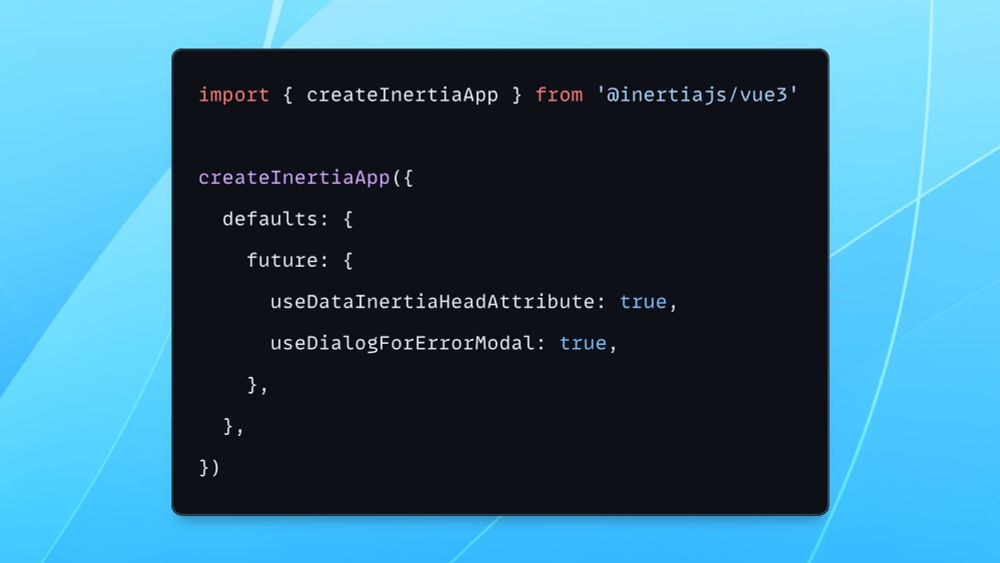Husband of Esmée, dad of Loïs and Kate ❤️
Works at @laravel.com. Open-source enthusiast. Also builds inertiaui.com.
https://pinkary.com/@pascalbaljet
Very cool! The web version of Apple Music is Svelte as well ✌️
If you're using Svelte, what do you like about it, especially compared to Vue?

Very cool! The web version of Apple Music is Svelte as well ✌️
If you're using Svelte, what do you like about it, especially compared to Vue?
✅ Opt in to the new <Dialog> element for error modals
✅ Let the <Head> component use the 'data-inertia' attribute instead of 'inertia'

✅ Opt in to the new <Dialog> element for error modals
✅ Let the <Head> component use the 'data-inertia' attribute instead of 'inertia'
This callback receives the URL and options for the visit, and returns an object with options to merge in. Perfect for enabling View Transitions globally, for example 😉

This callback receives the URL and options for the visit, and returns an object with options to merge in. Perfect for enabling View Transitions globally, for example 😉
First, you can override some defaults that were previously hardcoded, such as the default prefetch cache duration or the 'recentlySuccessful' duration in forms ⏳

First, you can override some defaults that were previously hardcoded, such as the default prefetch cache duration or the 'recentlySuccessful' duration in forms ⏳
We're introducing a way to set global defaults for Inertia! 🙌

We're introducing a way to set global defaults for Inertia! 🙌
The View Transitions API is a browser feature that lets you animate between pages. It can be a simple cross-fade, and you can even animate specific elements from one page to the next.
(slow video on purpose)
The View Transitions API is a browser feature that lets you animate between pages. It can be a simple cross-fade, and you can even animate specific elements from one page to the next.
(slow video on purpose)
All of this is in the docs! Enjoy! 📚

All of this is in the docs! Enjoy! 📚
It's a new middle ground between merge() and deepMerge() that gives you precise control over how props are merged.
You can now prepend props, and even specify multiple merge paths, including nested ones.

It's a new middle ground between merge() and deepMerge() that gives you precise control over how props are merged.
You can now prepend props, and even specify multiple merge paths, including nested ones.
To reduce some boilerplate, there are now several handy shortcuts to update a page prop 🪄

To reduce some boilerplate, there are now several handy shortcuts to update a page prop 🪄
You can now access the Progress Bar API! It's the exact same API that Inertia uses under the hood 📊

You can now access the Progress Bar API! It's the exact same API that Inertia uses under the hood 📊
You can set the loading threshold, provide a default loading indicator, provide custom trigger elements, use scroll containers, get programmatic access, and more!
The docs are extensive, so be sure to check them out! 📖

You can set the loading threshold, provide a default loading indicator, provide custom trigger elements, use scroll containers, get programmatic access, and more!
The docs are extensive, so be sure to check them out! 📖
You may even choose to switch to manual after a certain number of automatic loads 👌

You may even choose to switch to manual after a certain number of automatic loads 👌
It flips the loading direction so scrolling up loads the next page, and scrolling down loads previous pages.

It flips the loading direction so scrolling up loads the next page, and scrolling down loads previous pages.
It automatically detects when you reach the end of the page and fetches the next chunk of data.

It automatically detects when you reach the end of the page and fetches the next chunk of data.
It works with full, simple, and cursor pagination, plays nice with Eloquent API resources, and also supports custom pagination implementations 🙌

It works with full, simple, and cursor pagination, plays nice with Eloquent API resources, and also supports custom pagination implementations 🙌

These are handy shortcuts for common patterns we've seen in the wild.

These are handy shortcuts for common patterns we've seen in the wild.




This lets you group related props into a single class. The RenderContext object gives you access to the component name and the request instance. Check out all the ways you can use it in the Inertia::render() method!


This lets you group related props into a single class. The RenderContext object gives you access to the component name and the request instance. Check out all the ways you can use it in the Inertia::render() method!
At first glance, it looks like Laravel's Arrayable interface, but here you get a PropertyContext object, which gives you access to the property key, the request instance, and all other props for the page.


At first glance, it looks like Laravel's Arrayable interface, but here you get a PropertyContext object, which gives you access to the property key, the request instance, and all other props for the page.




